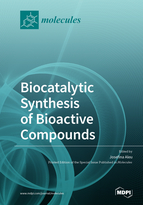Biocatalytic Synthesis of Bioactive Compounds
A special issue of Molecules (ISSN 1420-3049). This special issue belongs to the section "Natural Products Chemistry".
Deadline for manuscript submissions: closed (31 August 2020) | Viewed by 36134
Special Issue Editor
Interests: organic chemistry; enzymatic synthesis; biotransformations; bioactive molecules; secondary metabolism; marine fungi; phytopathogenic fungi
Special Issue Information
Dear Colleagues,
Biocatalysis, the application of enzymes as catalysts for chemical synthesis, has become an increasingly valuable tool for the synthetic chemist. Enzymatic transformations carried out by enzymes or whole-cell catalysts are used for the production of a wide variety of compounds, from bulk chemicals to fine ones. The primary consideration for the incorporation of a biotransformation in a synthetic sequence is the regio- and stereo-control that can be achieved with an enzyme-catalyzed reaction. Biotransformations are thus becoming accepted as a method for generating optically pure compounds, as well as for developing efficient routes to target compounds. This Special Issue aims to the main applications of biocatalysts, isolated enzymes, and whole microorganisms for the synthesis of bioactive compounds and their precursors.
Dr. Josefina Aleu
Guest Editor
Manuscript Submission Information
Manuscripts should be submitted online at www.mdpi.com by registering and logging in to this website. Once you are registered, click here to go to the submission form. Manuscripts can be submitted until the deadline. All submissions that pass pre-check are peer-reviewed. Accepted papers will be published continuously in the journal (as soon as accepted) and will be listed together on the special issue website. Research articles, review articles as well as short communications are invited. For planned papers, a title and short abstract (about 100 words) can be sent to the Editorial Office for announcement on this website.
Submitted manuscripts should not have been published previously, nor be under consideration for publication elsewhere (except conference proceedings papers). All manuscripts are thoroughly refereed through a single-blind peer-review process. A guide for authors and other relevant information for submission of manuscripts is available on the Instructions for Authors page. Molecules is an international peer-reviewed open access semimonthly journal published by MDPI.
Please visit the Instructions for Authors page before submitting a manuscript. The Article Processing Charge (APC) for publication in this open access journal is 2700 CHF (Swiss Francs). Submitted papers should be well formatted and use good English. Authors may use MDPI's English editing service prior to publication or during author revisions.
Keywords
- Biocatalysis
- Biotransformations
- Enzymatic synthesis
- Bioactive compounds







